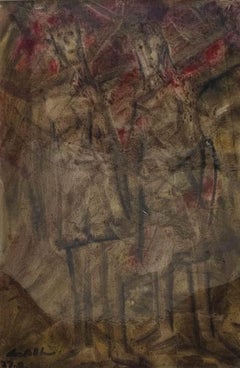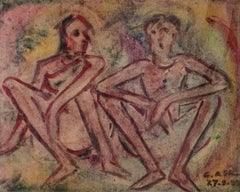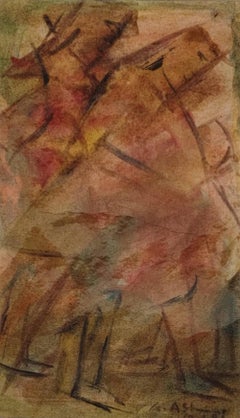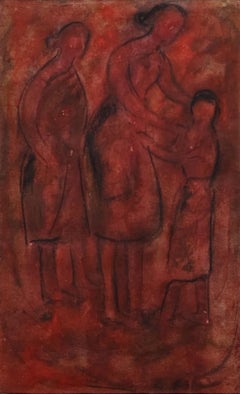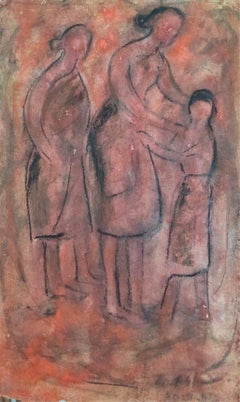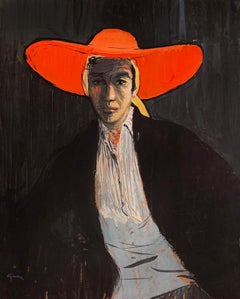Gobardhan Ash Art
to
5
5
4
1
Untitled, Figurative, Gouache on Paper by Gobardhan Ash "In Stock"
By Gobardhan Ash
Located in Kolkata, West Bengal
Gobardhan Ash - Untitled
Gouache on Paper
14.75 x 9.5 inches
( Framed & Delivered )
In this hauntingly expressive piece, Gobardhan Ash captures ghostly human forms through a subdued...
Category
1980s Modern Gobardhan Ash Art
Materials
Paper, Gouache
Untitled, Figurative, Gouache on Paper by Gobardhan Ash "In Stock"
By Gobardhan Ash
Located in Kolkata, West Bengal
Gobardhan Ash - Untitled
Gouache on Paper
10 x 12.5 inches
( Framed & Delivered )
His expressive line work and muted palette breathe life into this intimate portrayal of two seated ...
Category
1990s Modern Gobardhan Ash Art
Materials
Paper, Gouache
Untitled, Figurative, Gouache on Paper by Gobardhan Ash "In Stock"
By Gobardhan Ash
Located in Kolkata, West Bengal
Gobardhan Ash - Untitled
Gouache on Paper
13.25 x 7.5 inches
( Framed & Delivered )
In this evocative composition, Gobardhan Ash masterfully blends abstraction with suggestion, usin...
Category
1980s Modern Gobardhan Ash Art
Materials
Paper, Gouache
Untitled, Figurative, Gouache on Paper by Gobardhan Ash "In Stock"
By Gobardhan Ash
Located in Kolkata, West Bengal
Gobardhan Ash - Untitled
Gouache on Paper
13 x 8 inches
( Framed & Delivered )
In this tender composition, Gobardhan Ash captures an intimate moment of familial connection through s...
Category
1980s Modern Gobardhan Ash Art
Materials
Paper, Gouache
In the Village, Gouache on Paper, Pink & Red color by Gobardhan Ash "In Stock"
By Gobardhan Ash
Located in Kolkata, West Bengal
Gobardhan Ash - Untitled - Gouache on Paper
10 x 15 inches (unframed size)
Style : Regarded as a pioneer of modern Indian art, Ash’s contribution at the time when India witnessed the advent of Western modernism is significant and colossal. His work was exploratory, visionary and inspiring. He printed with bold courage and a free spirit, never yielding to the rules set by official art. He rejected the preconceived notions of how an artist ought to render his subjects and inevitably rebelled against the academic rules “ If we look at nature in the open, we do not see individual objects each with its own colors but rather a bright medley of tints which blend in our eyes, in our minds.” – Gobardhan Ash (The Statesman, April 24, 1994).
His verbal imagery alluded to what was real and relevant in India yet transcended to communicate a deeper, universal message about the human spirit. Disillusioned with the limits and constraints he faced, Ash withdrew into his private introspective world to explore his own mode of artistic expression. And although it was the convention then to paint divinities or exotic female figures on their way to the temple, Ash embarked on a new approach altogether to paint farmers toiling in the fields, workers engaged in intense labor to earn their living, thereby setting a new trend of socio-realistic art in India.
In 1945, Ash was brought into the public eye when the progressive writers Association discovered his series of paintings on the Bengal famine. The paintings depict, if not document, the ravages of the 1943 catastrophe. In juxtaposition to the famine series, his impressionist and post impressionist gouaches during the late 40s come as an interesting antithesis. Colors, rich and vibrant, come alive in a pulsating tone to dominate the entire painting.
Ash never subscribed to a stringent artistic form or technique. Rather, his works from the 80s display yet another intriguing and jarringly different style in his treatment of portraiture. His colors, with the exception of the apparent outlines, are reduced to smudges and smears so that the painting appear to originate from stained canvas. His subjects, spectral figures that engage and draw us within their profound state of despair and helplessness.
To characterize the life works of Gobardhan Ash is to recognize the complexity and spontaneity of his ideas and the enormous richness of his style. An artist who devoted his entire life to art, his paintings have transited and evolved from monochromatic sketches and landscape to portraiture; from naturalistic real-life depictions to abstract expressionism. Whatever the genre style-Ash has demonstrated an eloquent mastery over the diverse style, techniques and medias employed, as evident in the vast retrospective collection. His paintings are conceptual and purposeful, displaying a unique individuality. His art expounds a frank desire to convey the value of uncompromising artistic sincerity. Gobardhan Ash remains today a prolific artist of his time.
About the Artist & his works :
Born : Regarded as a pioneer of modern Indian art, Gobardhan Ash (1907-1996) was born at the village of Begampur in Hoogly district of West Bengal..
Family : His father was Haricharan Ash and mother Gouri Devi. He spent all his life in this village and died here in 1996 at the matured age...
Category
1980s Modern Gobardhan Ash Art
Materials
Paper, Pastel, Gouache
Related Items
Figure in a Wide-brimmed Red Hat
By René Gruau
Located in Miami, FL
Elegant and graphic study of a figure of undetermined gender. It's executed with quick and confident brush strokes in the artist's signature color scheme of black and red. It's a fla...
Category
1960s Contemporary Gobardhan Ash Art
Materials
Pastel, Mixed Media, Gouache, Board
Exquisite India Miniature Persian European Illustration Erotic Signed 1921
Located in Norfolk, GB
Couple at play
Watercolour on paper laid to board
21cm x 14cm
Mounted 39cm x 29cm
1921
Signed with Monogram Bottom right
This is an exquisitely executed watercolour painting that ...
Category
1920s Other Art Style Gobardhan Ash Art
Materials
Watercolor, Laid Paper
$1,808
H 8.27 in W 5.91 in
Framed Art Nouveau Period Painting A Greek Love Affair Theseus And Ariadne
By Antoine Calbet
Located in Sutton Poyntz, Dorset
Follower of Antoine Calbet.
French ( b.1860 - d.1944 ).
Theseus and Ariadne, Circa 1890 - 1910.
Mixed Media.
Watercolour, Gouache & Pastel
Image size 16.5 inches x 11.2 inches ( 42cm...
Category
Early 1900s Art Nouveau Gobardhan Ash Art
Materials
Pastel, Gouache, Watercolor, Paper
$1,734
H 18.51 in W 13.39 in D 0.89 in
Charles Levier [Solitude de Pierrot] signed large oil on canvas circa 1950
By Charles Levier
Located in Miami, FL
CHARLES LEVIER – [SOLITUDE DE PIERROT
⚜ Oil on Canvas ⚜ Hand Signed Lower Right ⚜ Original Period Frame
A THEATRICAL PORTRAIT OF MELANCHOLY
“Solitude de Pierrot” captures Charles Levier’s fascination with the archetypal Pierrot from commedia dell’arte. With angular black outlines and muted pastel tones, Levier reduces the figure to its essential gestures, creating a poignant symbol of isolation and quiet reflection. The vertical format emphasizes Pierrot’s elongated stance, while his downcast eyes and red-tipped nose heighten the painting’s emotive impact. This work was acquired directly from the artist by noted Beverly Hills designer Dean Richard Kukuk and retains its original Martin Lowitz Gallery label, underscoring both provenance and historical context.
WHY COLLECT THIS WORK?
✓ An early and expressive Charles Levier oil from circa 1950
✓ Features the Pierrot subject, connecting to the theatrical tradition of commedia dell’arte
✓ Strong provenance: Martin Lowitz Gallery, Los Angeles, and the collection of Dean Richard Kukuk, Beverly Hills
✓ Retains its original period frame in excellent condition with gallery label affixed verso
ARTWORK DETAILS:
▸ Title: [Solitude de Pierrot]
▸ Artist: Levier, Charles
▸ Medium: Oil on Canvas
▸ Creation Date: circa 1950
▸ Country of Creation: US
▸ Signed: Hand Signed Lower Right
▸ Current Condition: Excellent commensurate with age. Original period frame in great condition consistent with age.
▸ Documentation: Martin Lowitz Gallery label affixed to verso
▸ Provenance: Martin Lowitz Gallery, Los Angeles; Dean Richard Kukuk, Los Angeles
▸ Dimensions:
— ◼︎ Canvas Size: 44.25 inches x 15 inches
— ◻︎ Frame Size: 59 inches x 30 inches x 2.625 inches
INCLUDED DOCUMENTATION
✓ Certificate of Authenticity
✓ Artist Biography Document
THE ARTIST:
Charles Levier (1920–2003) was a French-American painter known for expressive oils, gouaches, and watercolors that bridge Modernism and postwar design sensibilities. His subjects include harbor towns, still lifes, café society, and commedia dell’arte figures such as Pierrot and Harlequin. Levier’s linear bite and stylized elongations have invited comparison to Bernard Buffet, while collectors of Modigliani, Rouault, and mid-century École de Paris painting...
Category
1950s Modern Gobardhan Ash Art
Materials
Canvas, Oil
Charles LevierCharles Levier [Solitude de Pierrot] signed large oil on canvas circa 1950, circa 1950
$9,500
H 59 in W 30 in D 2.625 in
Still life , 65x50cm, paper/ pastel/ gouache
By Aleksandra Mato
Located in Yerevan, AM
Still life
Category
2010s Contemporary Gobardhan Ash Art
Materials
Paper, Pastel, Gouache
$750 Sale Price
25% Off
H 25.6 in W 19.69 in
1950s "Eve" American Modern MidCentury Figurative Gouache & Oil Pastel
By Donald Stacy
Located in Arp, TX
Donald Stacy
"Eve"
c.1950s
Gouache and oil pastel on paper
14x17" black wood frame 14.75"x17.75"
Unsigned, Eve written in paint along right margin
Came from artist's estate
Donald S...
Category
Mid-20th Century American Modern Gobardhan Ash Art
Materials
Paper, Gouache, Oil Pastel
$760 Sale Price
20% Off
H 17.75 in W 14.75 in
Twentieth Century Watercolour Portrait and Equine Study
By Edward Seago
Located in ludlow, GB
Twentieth Century Watercolour Portrait and Equine Study showing Clowns and Circus Horses.
This is highly typical of one of the important strands of Edward Seago's work - he was fascinated by the Circus and by the Travelling community.
Edward Seago is a giant of 20th Century British paintings...
Category
Early 20th Century Naturalistic Gobardhan Ash Art
Materials
Watercolor
$2,142
H 12 in W 8 in D 1 in
Glassblowers WPA American Scene Mid- 20th Century Modern Figurative Workers 1932
By Harry Gottlieb
Located in New York, NY
Glassblowers WPA American Scene Mid- 20th Century Modern Figurative Workers. Dated and signed "32 Harry Gottlieb" lower right. Sight: 13 1/8" H x 18 1/4" W.
Harry Gottlieb, painter, screenprinter, educator, and lithographer, was born in Bucharest, Rumania. He emigrated to America in 1907, and his family settled in Minneapolis. From 1915 to 1917, Gottlieb attended the Minneapolis Institute of Arts. After a short stint as an illustrator for the U.S. Navy, Gottlieb moved to New York City; he became a scenic and costume designer for Eugene O"Neill's Provincetown Theater Group. He also studied at the Philadelphia Academy of Fine Arts and the National Academy of Design.
He was one of America's first Social Realist painters, influenced by that Robert Henri-led movement in New York City where Gottlieb settled in 1918. He was also a pioneer in screen printing, which he learned while working for the WPA. He married Eugenie Gershoy, and the couple joined the artist colony at Woodstock, New York. He lectured widely on art education.
In 1923, Gottlieb settled in Woodstock, New York and in 1931, spent a a year abroad studying under a Guggenheim Fellowship.
In 1935, he joined the Federal Art Project...
Category
1930s American Modern Gobardhan Ash Art
Materials
Paper, Gouache
Harry GottliebGlassblowers WPA American Scene Mid- 20th Century Modern Figurative Workers 1932, 1932
$4,400
H 21 in W 26 in D 2 in
1950s "Black Floor" Mid Century Bay Area Figurative Movement Gouache Painting
Located in Arp, TX
From the estate of Jerry Opper & Ruth Friedman Opper
Black Floor
c. 1940-1950's
Gouache on Paper
15" x 18" Unframed
*Custom framing available for additional charge. Please expect framing time between 3-5 weeks.
From the estate of Ruth Friedmann Opper & Jerry Opper. Ruth was the daughter of Bauhaus artist, Gustav Friedmann.
San Francisco Abstract Expression
A free-spirited wave of creative energy swept through the San Francisco art community after World War II. Challenging accepted modes of painting, Abstract Expressionists produced highly experimental works that jolted the public out of its postwar complacency.
Abstract Expressionism resulted from a broad collective impulse rather than the inspiration of a small band of New York artists. Documenting the interchanges between the East and West Coasts, she cites areas of mutual influence and shows the impact of San Francisco on the New York School, including artists such as Mark Rothko and Ad Reinhardt. San Francisco's Beat poets...
Category
Mid-20th Century American Modern Gobardhan Ash Art
Materials
Paper, Gouache
"Tighties" 1950's Gouache Male Nude Mid Century Painting
By Jerry Opper
Located in Arp, TX
From the estate of Jerry Opper & Ruth Friedman Opper
Tighties
c. 1950's
Gouache on Paper
15" x 18" blue lacquered frame 18.5"x1.75"x21.5"
Unsigned
From the estate of Ruth Friedmann Opper & Jerry Opper. Ruth was the daughter of Bauhaus artist, Gustav Friedmann...
Category
Mid-20th Century Modern Gobardhan Ash Art
Materials
Paper, Gouache
1950s "Curled Up Cubist" MidCentury Figurative Gouache University of Paris
By Donald Stacy
Located in Arp, TX
Donald Stacy
"Curled Up Cubist
c.1950s
Gouache on paper
24" x 18" unframed
Unsigned
Came from artist's estate
Donald Stacy (1925-2011) New Jersey
Studied: Newark School of Fine Art
The Art Students League
Pratt Graphic Arts Center
University of Paris 1953-54
University of Aix-en-Provence 1954-55
Faculty: Art Department of the New School
Museum of Modern Art
School of Visual Arts
Stacy Studio Workshop
Exhibitions: Grand Central Moderns
George Wittenborn
The New School
Print Exhibitions, Chicago
University of Oklahoma
Honolulu Museum
Monclair Museum
Wisconsin State College
Louisiana Art Commission
Philadelphia...
Category
Mid-20th Century American Modern Gobardhan Ash Art
Materials
Paper, Gouache
Modernist Portrait of a Woman
By Margaret Keane
Located in Milford, NH
A fine modernist portrait of a woman by American artist Margaret Hawkins Keane (1927-2022). Keane was born in Nashville,TN, and attributes her deep respect for the Bible and inspirations of her artwork to the relationship with her grandmother. In the 1960’s, while married to her second husband Walter, she was forced to paint and sell under his name, but during their divorce proceedings, she was able to prove that the paintings were actually done by her and the court determined that she was able to paint under her own name again. She became known for painting women and children with large black sad eyes...
Category
Mid-20th Century Modern Gobardhan Ash Art
Materials
Canvas, Oil
Gobardhan Ash art for sale on 1stDibs.
Find a wide variety of authentic Gobardhan Ash art available for sale on 1stDibs. You can also browse by medium to find art by Gobardhan Ash in gouache, paint, paper and more. Much of the original work by this artist or collective was created during the 1980s and is mostly associated with the modern style. Not every interior allows for large Gobardhan Ash art, so small editions measuring 9 inches across are available. Customers who are interested in this artist might also find the work of Dhiraj Chowdhury, Amitabha Banerjee, and Manu Parekh. Gobardhan Ash art prices can differ depending upon medium, time period and other attributes. On 1stDibs, the price for these items starts at $765 and tops out at $1,500, while the average work can sell for $1,001.
